
Cow Pregnancy Calculator
Estimate when your cow is due to give birth by entering the date of the first mating below and stay prepared for additions of new calves to your family!How Long Are Cows Pregnant?
Given the sheer size and needs of a cow, their pregnancies are usually very stressful both to the animal and to their caretaker. It is important that you understand exactly what you are getting yourself into so that you best know how to take care of your cow as they create and deliver life.
On average, a cow’s pregnancy is about 283 days which corresponds to 9 months and about 2 weeks. The pregnancy is divided into 3 main stages.
The first stage runs from the point of conception to 3 months. This is a relatively high-risk period with the cow experiencing the highest risk of suffering a miscarriage.
The second stage runs from the 4th month to the end of the 6th month. This is a relatively quiet time in the cow’s pregnancy with minimal development of the fetus and very few changes observable in the cow.
Finally, there is the 3rd stage from the 7th month to the point of calving. Here is where most of the development occurs with about 70% to 75% of the growth of the fetus happening here.
In the sections below, we shall take a closer look at the month-to-month progression of the cow’s pregnancy. That way, you will have a better idea of what to expect and how best to take care of your cow.
Pregnant cows in the 1st month (Trimester 1)
What to expect
The first month runs from day 0 to day 30.
In a cow’s pregnancy, day 0 is marked by ovulation which occurs when the cow is in the estrus stage of their heat cycle. The breeding or artificial insemination should occur within 24 hours of the ovulation to increase the chances of successful fertilization.
If the fertilization occurs successfully, a zygote is formed and begins a sequence of cell divisions. By day 3, the single-celled zygote will have developed into an 8 cell mass making its way towards the uterus for implantation.
The cell mass will typically arrive within the uterus by the end of the 2nd week after fertilization. What follows after this is implantation which happens by day 21 and subsequent formation of the placenta that occurs at around day 25.
How to care for the cow
The newly-formed embryo is at highest risk of being miscarried during the first month. That is why adequate care is so important for both the cow and their embryo. Here are a few tips that may come in handy.
Avoid changes to the cow’s environment or routine to minimize stress.
Ensure that the cow is well-fed.
Reduce the amount of work required from the cow.
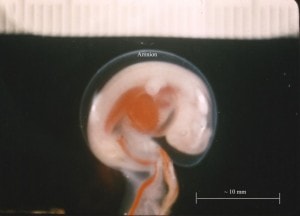
Pregnant cows in the 2nd month (Trimester 1)
What to expect
The second month of the cow’s pregnancy runs from day 31 to day 60.
The embryo at this stage is the size of a mouse and is undergoing the first stages of development of different important organs and systems including the brain, heart, and liver.
It is also at this point that their reproductive organs start to form. For male embryos, the testicles will have formed by day 45 while the female reproductive tract forms between day 50 and day 60.
Unlike the 1st month, there is much less risk of miscarriage or embryo resorption during the second month of the pregnancy. The risk is lowest after day 42 and just progressively gets lower as the pregnancy progresses.
At this stage, there may not be any noticeable signs that the cow is pregnant. However, if the insemination or breeding was timed and recorded, you will be able to keep track of the pregnancy before the cow’s body starts to experience pregnancy changes.
How to care for the cow
The care needs for the pregnant cow remain pretty much the same during the second month as they were in the first. This means feeding your cow adequately and minimizing the amount of stress they are exposed to.
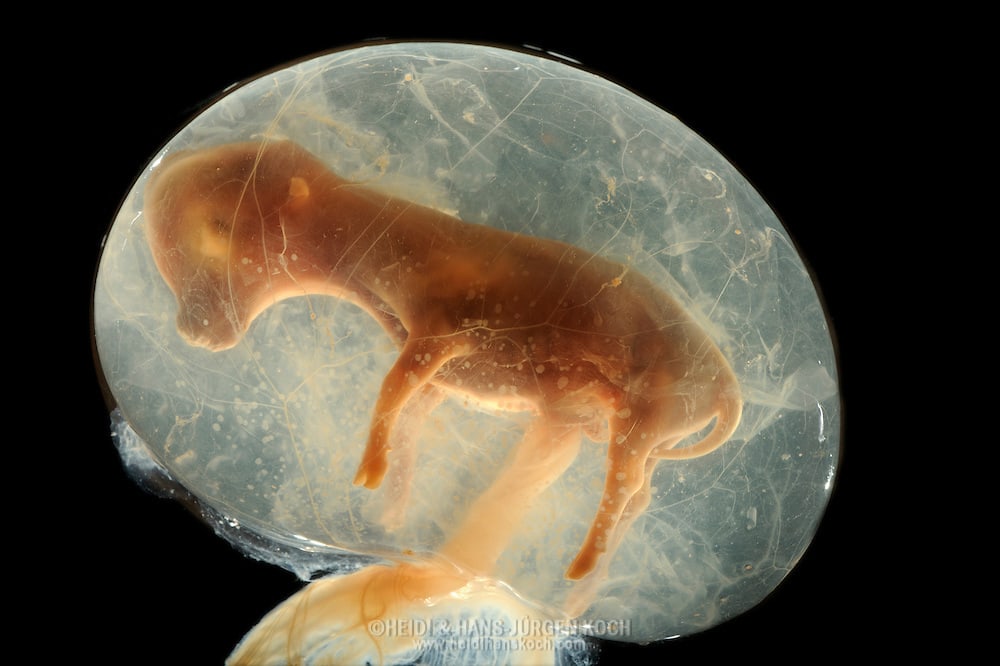
Pregnant cows in the 3rd month (Trimester 1)
What to expect
The third trimester runs from day 61 of the pregnancy to day 90.
This is a relatively quiet period of the cow’s pregnancy. Within the uterus, the fetus continues to develop with the organs that started to form in the 2nd month getting larger and better defined. The limbs also start to form during the 3rd month.
The body dimensions also begin to change with the developing fetus taking the form and proportions of a calf by day 70.
Another important note is that while the heartbeat can be heard as early as day 25, it is best heard in the 3rd month as the heart and the embryo’s circulatory system are better developed.
Another important milestone for the fetus in the uterus is the fact that they start to develop early hair follicles at around the 90 day mark.
When it comes to the cow itself, the features of the pregnancy will start to be more noticeable. These include:
Calmer behavior especially compared with the restlessness they had while on heat.
Increased abdominal girth with uniform rounding.
Increased size of the udders. They may also start to darken.
In addition to these initial signs, the pregnancy can easily be confirmed by performing an ultrasound. This will also let you know the status of the fetus and may help predict the likely outcome.
How to care for the cow
The care needs and practices for the cow are the same during the 3rd month as it is in the first two. This is because there are very few changes occurring in both the fetus and the cow. Just make sure that the cow is well fed and at peace and your job will be done here.
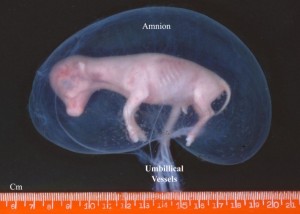
Pregnant cows in the 4th month (Trimester 2)
What to expect
The fourth month of the cow’s pregnancy covers day 91 to day 120. This also marks the beginning of the second trimester of the pregnancy.
At this stage, the cow fetus is roughly the size of a small cat and grows relatively slowly. Their limbs continue to lengthen with some bones beginning the process of ossification as early as day 100.
Day 100 is also a huge milestone for the fetus as this is when their horn pits start to appear.
Another important day in the 4th month of the cow’s pregnancy is day 110 where the fetus starts developing pigmentation of the hair follicles and the teeth start to form.
Considering the size of the growing fetus relative to the size of an average adult cow, there may not be a lot to note during the 4th month in terms of physical pregnancy changes in the cow. However, you may notice a few behavioral changes like the cow getting calmer and more reserved.
How to care for the cow
There isn’t a lot changing in the cow’s body or for the fetus. Therefore, you may not need to make any changes to the care practices you have been implementing in the previous months of the cow’s pregnancy.
However, you may want to start increasing the feeds for the cow to support their gradually increasing requirements.
Furthermore, it is best to start limiting breastfeeding or milking the cow if they were still producing milk. It is probably too early to completely stop milking but consider limiting the frequency of the milking.
Pregnant cows in the 5th & 6th month (Trimester 2)
What to expect
The 5th month of the cow’s pregnancy is counted from day 121 to day 150 while the 6th month lasts until day 180.
It is a pretty uneventful time in the cow’s pregnancy. The different organs and structures that had already begun forming just continue to grow in size and develop into more of their better-differentiated forms.
By the end of the 6th month, the fetus will be the size of a small dog and strongly resembles a calf in terms of the shape and body proportions.
The cow may also not experience a lot of changes physically. However, you may notice that your cow has a bigger appetite than normal. They will also start to put on some weight. The weight gain is all over the body and not specifically in the abdomen area.
How to care for the cow
Gradually increase the amount of food that you give to your cow over these 2 months. It would help to consult your vet on how much and how often to feed the cow as the requirements vary from one cow to another.
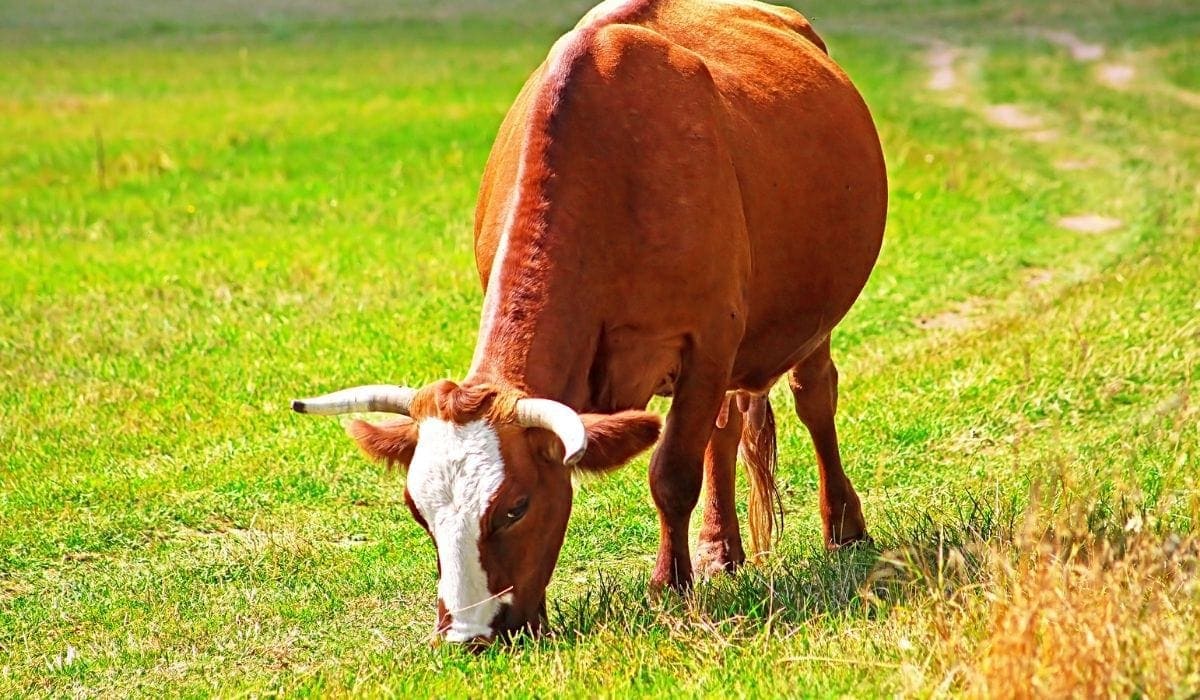
Pregnant cows in the 7th month (Trimester 3)
What to expect
The 7th month in the cow’s pregnancy runs from day 181 to day 210. It also marks the beginning of the 3rd trimester. This is where the fetus goes through most of its growth and development. As a result, the changes in the cow’s body and behavior are more noticeable.
The fetus in this month measures about 60 cm in length. This is equivalent to a medium-small dog. The coew's fetus also begin to develop hair towards the end of the 7th month. However, the hair in this case is limited to certain areas including around the horn roots. Another notable area of increased hair grown is the tail that gets long hair strands similar to what you would find in a calf or adult cow.
Meanwhile, the cow starts to experience marked changes in their physique as a result of the rapidly growing fetus. There will likely be increased girth around the cow’s abdomen. This distention is typically asymmetrical and based on the position of the fetus.
In terms of behavior changes in the cow, you can expect to deal with an increase in appetite and reduced energy levels.
How to care for the cow
All the changes happening in both the cow and the fetus necessitate a change in the care regimen that you use on your pregnant cow. Here are a few tips you could work with.
Increase the amount of food you give your cow.
Focus on feeds or supplements that are enriched with micronutrients.
Stop milking the cow if it is a lactating dairy cow.
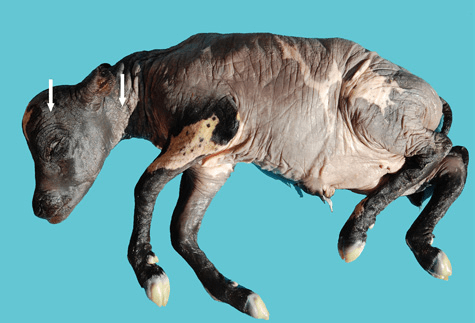
Pregnant cows in the 8th month (Trimester 3)
What to expect
The 8th month spans from day 211 to day 240. It is another important stage in the cow’s pregnancy as there is rapid growth for the fetus within the uterus.
By the end of the 8th month, the fetus will measure 75cm, give or take a few centimeters. Another important change that occurs during this month is the increase in the length and distribution of the hair on the fetus. As the 8th month winds up, most of the fetus’s back, face, forehead, and ears are fully covered by hair.
On the other hand, the cow continues to get much bigger as their appetite and food intake increase. The increasing size of the fetus also contributes to the ballooning in weight and dimensions. If you have stopped milking the cow by this time, the increase in weight will be even more noticeable.
During the 8th month, there are also some changes in the udder size and color. The udder gets larger and more hyperpigmented. Similar changes may or may not be observed in the vulva with accompanying mucoid discharge. These changes are usually seen towards the end of the 8th month.
How to care for the cow
Just continue feeding your cow adequate portions of high quality and balanced feeds. It is also important to minimize the amount of stress that the cow is exposed to so as to minimize the chances of triggering premature labor.
It is also best to start making preparations for the calving period. This is because despite the pregnancy lasting upwards of 270 days, it is very possible that the cow could deliver at any point in their 9th month of pregnancy.
You can prepare by identifying a good, clean, and safe spot for the cow to nest and go through the calving and postpartum nursing peacefully. If you don’t already have a veterinarian on call, this is also the time to start actively looking for and working with one.
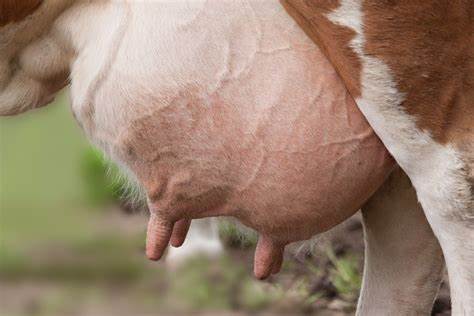
Pregnant cows in the 9th month (Trimester 3)
What to expect
The 9th month generally refers to any time in the cow’s pregnancy from day 241 to the calving. For some cows, this can last to day 270 but most usually reach day 285.
During this period the fetus goes through further growth and could grow up to 100 cm in length by the time of calving. The fetus also develops a full coat with hair covering the entire body as would be expected for a newborn calf.
The most important milestone during the 9th month is maturation of the lungs in preparation for the newborn calf’s impending independence from their mother’s nourishment and oxygen supply. This lung maturation occurs about a week or two to the calving.
The most important changes to note in the cow during this stage are the signs that they are either about to deliver or in active labor. Here are a few of these signs that you should keep an eye out for during the entire 9th month of the cow’s pregnancy.
Rapid increase in udder size with teats sticking out at an angle.
Red, puffy, and loose vulva.
Increased vulval discharge that is likely from losing the cervical plug.
Increased restlessness with simultaneous low energy levels.
How to care for the cow
During the last few weeks leading up to the calving, the cow’s care needs are very limited. Just keep them well fed, adequately hydrated, and generally comfortable. If possible, consider getting a veterinarian actively involved in the care and monitoring of the cow especially after day 260 as the calf can come at pretty much any time.
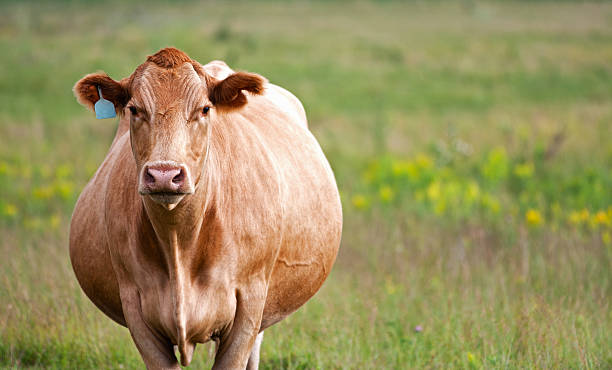
During calving of a cow's pregnancy
What to expect
After a little over 9 months of waiting, the calving is finally here. We have already highlighted some of the telltale signs that your pregnant cow is about to give birth. In this section, we shall take a look at the actual calving process including what to do to support your cow.
There are 3 stages of labor in a cow.
The first stage starts when the cow starts getting uterine contractions and stops when the cervix dilates. This lasts about 12 hours but may take long for first time cow mothers as well as situations where there is complicated labor.
The second stage is the actual labor and should last 1 to 2 hours. The dilated cervix allows for passage of the amniotic sac with the fetus inside. The fetus should come out with the front feet first then their head and the rest of the body. The actual calving can either happen with the cow standing or laying down.
Finally, the third stage is characterized by the passage of the placenta which should happen a few hours after the last of the calves is delivered. If the placenta is retained, you may need a vet or other trained and experienced individual to manually retrieve it.
How to care for the cow
If the delivery is uncomplicated, the cow should be able to do all the heavy lifting. If there are complications including prolonged labor or breech presentation, your cow may need assisted calving services offered by a trained professional.
Whatever the case, here are a few things you can do to help the cow prepare and get through the delivery.
- Clean the cow’s vulval region and under the tail to clear any fecal matter or other debris.
- Have clean towels at hand to wipe and wrap the calves in case the cow is unable to offer immediate care to the newborn calves.
- Constantly monitor the cow for signs of distress to identify a cow in need of assisted calving. This includes prolonged second stage of labor or a calf seemingly stuck despite continuous contractions.
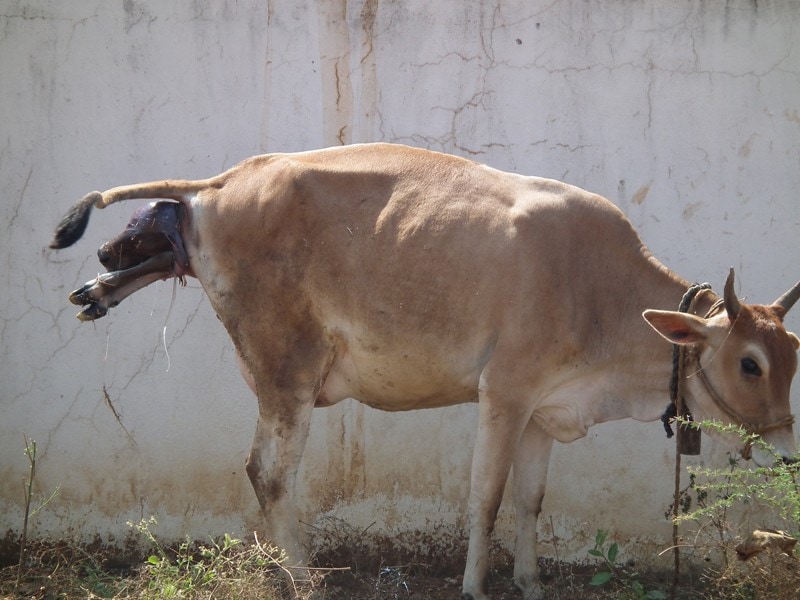
Post-partum period of cow pregnancy
What to expect
The post-partum period of a cow is a very sensitive time as so much could go wrong with inadequate care. To help you prepare for this period, here are a few common postpartum complications that the cow may get and how to identify them.
Retained fetal membranes
This refers to a situation where fetal membranes including the placenta are not effectively expelled from the uterus. This retention could cause prolonged bleeding which could be life-threatening. Furthermore, the retained products could leave the cow at risk of developing uterine infections.
Puerperal metritis
Speaking of uterine infections, puerperal metritis is a serious complication involving infection and inflammation of any of the layers of the uterus. This complication can affect cows that don’t have retained fetal membranes.
You may notice a foul-smelling discharge from the vulva a few days after the pregnancy. The cow may also demonstrate other features of infection like fever, weakness, and general restlessness due to the discomfort.
Mastitis
Mastitis is an infection of the teats. More often than not, it only affects one teat but could affect multiple teats or even the entire udder set. The infection is marked by a marked swelling of the teat with hyperpigmentation. The affected teat will be warm and painful when touched.
How to care for the cow
The best way to prevent all these issues is by ensuring that the cow gets to nurse and recover in a clean and isolated space. You may consider cleaning their vulval area to prevent contamination from stool but this is not always necessary.
If you suspect that your cow has any of these complications, do not hesitate to reach out to your vet as soon as possible. The cow’s life may just depend on it.
